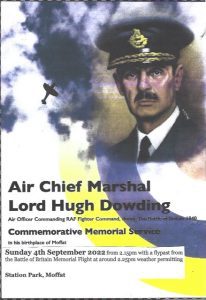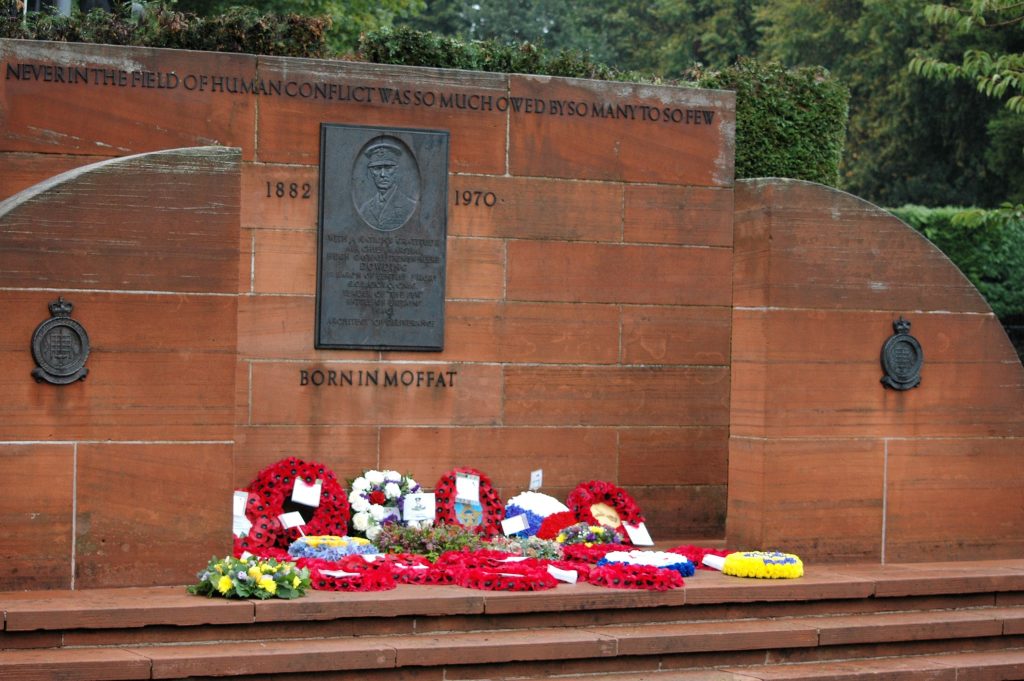Moffat is proud to have been the birthplace of Air Chief Marshal Hugh Dowding. A memorial stands in his honour in the town’s Station Park and, each September, a service is held in his memory. This year, the 82nd anniversary of the successful defence of the skies over Britain, he will be remembered again. To many, he was known as The Architect of Deliverance.
Sunday 4th September, Station Park, Moffat from 2.15pm
 At around 2.25pm, weather permitting, a Spitfire from The Battle of Britain Memorial Flight will make several passes over Station Park and the whole town. This year, it is expected to be a Griffin-engined Mk XIX Spitfire, flown once again by BBMF fighter pilot Flight Lieutenant Andy Preece MBE.
At around 2.25pm, weather permitting, a Spitfire from The Battle of Britain Memorial Flight will make several passes over Station Park and the whole town. This year, it is expected to be a Griffin-engined Mk XIX Spitfire, flown once again by BBMF fighter pilot Flight Lieutenant Andy Preece MBE.
At 2.30pm, in Station Park, there will be a simple ceremony of laying three wreaths, on behalf of Lord Piers Dowding, Lady Odette Dowding and the Town of Moffat – followed by wreaths from several other associated organisations.
Air Marshal Sir Baz North, President of the Royal Air Forces Association, will deliver The Tribute.
Mick Barker, from the Old Well Theatre in Moffat, will recite ‘High Flight’ by the fighter pilot John Magee: ‘Oh! I have slipped the surly bonds of Earth And danced the skies on laughter-silvered wings…’
Many VIPs will be present, including representatives from the Consulate General of the Republic of Poland and the Embassy of the Czech Republic.
HUGH CASWALL TREMENHEERE DOWDING, 1st BARON DOWDING
Air Chief Marshal Hugh Caswall Tremenheere Dowding, GCB, GCVO, CMG (24 April 1882 – 15 February 1970) served as a fighter pilot and then as commanding officer of No.16 Squadron during the First World War. During the inter-war years he became Air Officer Commanding Fighting Area, Air Defence of Great Britain and then joined the Air Council as Air Member for Supply and Research. He was Air Officer Commanding RAF Fighter Command during the Battle of Britain and is generally credited with playing a crucial role in Britain’s defence, and hence, the defeat of Adolf Hitler’s plan to invade Britain.
FIGHTER COMMAND IN SCOTLAND, 1939
During the Second World War, France was not defeated and occupied by Germany until June 1940. This gave them the platform for the invasion of Great Britain, to be preceded by the air assault which we now remember as the Battle of Britain. But, in 1939, well before the Battle of Britain, there were several important actions over Scotland involving Fighter Command, two of which are described here.
On the 16th October, 1939, the Luftwaffe’s Fleigerdivision’s I/KG 30, based at Westerland on the Island of Sylt, despatched nine Junkers 88 dive bombers, under the command of Hauptmann Helmuth Pohle. Their main objective was to bomb HMS Hood, reputed to be docked at Rosyth. Ironically Pohle was under orders from Hitler that he was not to bomb if there was a danger of civilian casualties!
They did not expect any real opposition as the crews had been told that Scotland was defended by obsolescent Gloster Gladiators. But, in fact, there were Spitfires of 602 (City of Glasgow) and 603 (City of Edinburgh) Squadrons at Drem (now East Fortune) and Turnhouse respectively.
The attack was a failure: Pohle was shot down in the Forth but managed to guide his doomed aircraft to ditch alongside a trawler. The crew rescued him, severely concussed, and he awoke five days later in hospital. The Luftwaffe lost four aircraft and five were badly damaged; all the downed aircraft fell into the sea; one of the enemy losses was a Heinkel 111, sent to observe the Junkers attack. There were no RAF losses.
On the 29th November, 1939, Archie McKellar, DSO, DFC & Bar (10 April 1912 – 1 November 1940) of 602 Squadron, spotted a Heinkel 111 over Dalkeith and attacked it, killing the dorsal gunner and damaging the aircraft. As he was about to attack a second time, two Spitfires from 603, under the command of Sqn Ldr E.H. Stevens, nipped in and shot it down, landing in a field at Kidlaw, near Haddington, East Lothian. It was the first enemy aircraft of the war to be downed on British soil.
THE BATTLE OF BRITAIN MEMORIAL FLIGHT (BBMF)
The Battle of Britain Memorial Flight was inaugurated in 1957 at RAF Biggin Hill. Initially it was known as The RAF Historic Aircraft Flight and consisted of three Mk XIX Spitfires and a Hawker Hurricane. It was renamed The BBMF in 1969. It now maintains twelve historic and irreplaceable aircraft, an Avro Lancaster, a Dakota, six Spitfires, two Hurricanes and two de Havilland Chipmunk training aircraft.
DOWDING HOUSE
Dowding House, in Moffat, formerly St Ninian’s School, was Lord Dowding’s birthplace, and is now a sheltered development, owned by the Royal Air Forces Association, and exclusively for the use of ex-RAF personnel.






